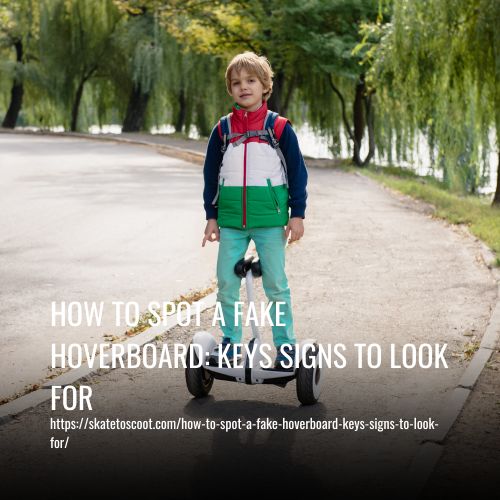As an Amazon Associate we earn from qualifying purchases.
To spot a fake hoverboard, there are several key indicators to look out for. First, check for the UL certification mark on the hoverboard. This mark ensures that the hoverboard has undergone safety testing and meets quality requirements.
Additionally, do thorough research on the manufacturer before making a purchase. Reputable companies will have positive customer reviews and a history of producing safe hoverboards. Beware of cheap hoverboard companies or knock-off brands that offer significantly lower prices.
So, let’s dive in and discover how to differentiate between the real deal and a fake hoverboard:
- Check the name.
- Price.
- How does it look?
- Check the Manual.
- Does the board have certification markers?
- Squeaking noise.
- Is the Name Spelt Correctly?
- Do They Respect Standards?
- Are They Too Light?
- Customer Reviews.

1. Check the name:
To spot a fake hoverboard, one of the key things you need to do is carefully check the name. Cheap knock-off hoverboards often try to imitate the design of authentic models, but due to copyright laws, they are unable to use the same name. Instead, they will use a name that is similar to the real thing, hoping to fool unsuspecting buyers.
For example, a fake hoverboard might resemble a popular brand like Segway, but upon closer inspection, you might notice a slightly altered name such as “Swegway” or “Swagway.” Some counterfeit companies may even go as far as completely changing the name altogether, making it more challenging to distinguish them from the authentic ones at first glance.
By thoroughly examining the name and comparing it to reputable brands, you can avoid falling for a fake hoverboard and ensure that you are purchasing a genuine and safe product.
2. Price:
Price can be a key indicator when trying to spot a fake hoverboard. If the price seems too good to be true, it is likely that the hoverboard is counterfeit. A decent hoverboard typically costs around $300, so if you come across one at a significantly lower price, be cautious.
Although you may find some hoverboards priced around $150, they may lack the same speed and battery power as higher-priced models. However, if the price is considerably lower than what you would expect for the specifications, it is best to walk away.
Cheaper hoverboards are more likely to be of poor quality, have a shorter lifespan, and pose safety risks such as catching fire or even exploding. To ensure the safety and longevity of your hoverboard, it is advisable to invest in a reputable and certified model from a trusted manufacturer rather than opting for cheap knock-offs.
3. How does it look?
When it comes to spotting a fake hoverboard, one of the key factors to consider is how it looks. An original hoverboard will have a distinct and premium appearance, reflecting the craftsmanship of top engineers from a reputable manufacturer.
Genuine hoverboards often have a price tag that matches their sleek and stylish design. On the other hand, a fake hoverboard may appear cheap or poorly made. If the hoverboard feels too light or the plastic feels flimsy, it is likely a knock-off.
Additionally, an authentic hoverboard will have a premium look and feel throughout, with no visible discrepancies in design or quality. No matter how affordable it may be, if something seems off about the appearance of a hoverboard, it’s best to avoid purchasing it.
4. Check the Manual:
Legitimate hoverboard manufacturers take great care in creating high-quality manuals with clear instructions and illustrations. If the manual has bad translations, typos, or grammatical errors, it is likely a knock-off.
No reputable company would approve a manual with such errors. Additionally, authentic hoverboard brands will have a website and contact information provided in the manual. If you bought a used hoverboard and it did not come with a manual, you can easily find one online if it is authentic.
Remember, the manual should be printed on quality paper and have coherent text and illustrations. Checking the manual is a simple yet effective way to ensure the authenticity and quality of your hoverboard.
5. Does the board have certification markers?
Yes, a genuine hoverboard should have UL 2272 certified markers underneath the unit. The UL certification signifies that the hoverboard has undergone extensive testing to ensure its safety.
It is essential to avoid purchasing a hoverboard that does not have this certification, as it may pose a risk of fire or other safety hazards. Always look for the UL certification markers as a crucial indicator of a reliable and safe hoverboard.
6. Squeaking noise:
A squeaking noise from a hoverboard can be a sign of a potential issue with its components or loose parts. A reliable and well-built hoverboard should not produce any squeaking noise. To ensure its quality, carefully shake the hoverboard and listen for any rattling or movement inside the hoverboard enclosure.
If you detect any loose parts or suspect a problem with the components, it is advisable to consult the hoverboard manufacturer or a reputable company for further inspection and assistance. Taking these necessary precautions can help identify a potential fake or low-quality hoverboard and ensure a safe and enjoyable hoverboarding experience.
7. Is the Name Spelt Correctly?
Counterfeit hoverboards often come from China and have intentionally misspelled names. For instance, a well-known hoverboard brand like Swegway might have an imitation called Smagway.
This misspelling is done for legal reasons, but it serves as a dead giveaway that the hoverboard is an imitation and should be avoided. While these fake hoverboards may appear identical to the original ones, they use inferior materials.
Therefore, it is essential to pay attention to the spelling of the hoverboard brand name to ensure you are purchasing an authentic and safe product.
8. Do They Respect Standards?
One of the key factors in determining whether a hoverboard is fake or authentic is whether or not it follows industry standards. Standards are rules and regulations put in place to ensure that manufacturers produce products that have been thoroughly tested and meet the necessary safety requirements.
A fake hoverboard will often not conform to these standards, which can pose serious risks to users. One way to determine if a hoverboard is fake is to check for the trading standard of BS1363 on the charger plug. This standard is required for all genuine hoverboards, and experts advise avoiding hoverboards that do not have this mark. By ensuring that a hoverboard respects industry standards, you can have greater peace of mind regarding its safety and quality.
9. Are They Too Light?
If a hoverboard is unusually light, this may indicate that it is made of inexpensive materials based on plastic. While being light in technology instinctively rhymes with good, in the case of hoverboards, it is important to remember that a hoverboard that is too light may lack durability and stability.
Cheaper plastic-based materials used in the construction of these hoverboards can compromise their overall quality and safety. When considering purchasing a hoverboard, it is essential to choose a reputable company that prioritizes quality control and adheres to safety requirements. Opting for certified hoverboards from a reputable manufacturer will ensure that you are investing in a safe, durable, and reliable hoverboard.
So, the next time you’re in the market for a hoverboard, make sure to check its weight and ensure that it falls within a reasonable range, aiming for a decent and safe hoverboard that will provide you with hours of fun without compromising on quality.
10. Customer Reviews:
Customer Reviews are a valuable tool for spotting a fake hoverboard. By reading reviews left by other customers on websites, you can get a sense of the quality and authenticity of the product. It is unlikely that you would be the first person to purchase a certain hoverboard model, so looking at the experiences of others can help you make an informed decision.
Fake hoverboards typically have low ratings and negative comments, serving as a warning sign. When shopping on platforms like Amazon, customer reviews are especially helpful as they come from real people with genuine opinions.
Additionally, searching for reviews specific to the hoverboard model you’re considering can provide more detailed insights and help you determine if it is a genuine and reliable product. Taking the time to read customer reviews can be a crucial step in ensuring a safe and satisfying hoverboard purchase.
Can Go Hoverkart be Trusted with Real Hoverboards?
Yes, Can Go Hoverkart can be trusted with real hoverboards. With over 5 years in the business and thousands of hoverboards sold, they have established themselves as a reputable company in the industry.
They prioritize quality and safety by using top-quality parts and materials and putting their hoverboards through a rigorous quality control process before shipping them out.
In addition, they offer a 1-year warranty on all of their hoverboards, providing assurance that their products are safe and reliable. If you are in search of a trustworthy source for real hoverboards, Can Go Hoverkart is a reliable option to consider.
Real vs. Fake Hoverboards
If you are in the market for a hoverboard, it’s important to be able to distinguish between a real and a fake one. With the increasing popularity of hoverboards, there has been an influx of cheap and counterfeit options on the market.
To ensure you are purchasing a genuine and safe hoverboard, be sure to buy from a reputable company or a legitimate online seller. One dead giveaway of a fake hoverboard is the lack of safety marks and certifications. Look for UL certification, which ensures that the hoverboard meets safety requirements.
Additionally, do your research and read customer reviews to determine if the hoverboard manufacturer has a track record of producing quality products. Be wary of bad translations or inconsistencies in the hoverboard manual, as this may suggest a non-functional or counterfeit hoverboard.
Why You Should Avoid Buying a Fake Hoverboard
While it may be tempting to save money by purchasing a counterfeit hoverboard, it could potentially put you at risk. Cheap hoverboards often lack the necessary safety features and may not comply with the required safety standards. Reports of hoverboards catching fire have raised serious concerns about the safety of these devices.
Genuine hoverboards are subjected to rigorous quality control and are equipped with UL certification, a clover-shaped plug, and safety marks. Investing in a reputable company that manufactures certified hoverboards ensures that you are purchasing a safe and reliable product.
Additionally, genuine hoverboards come with comprehensive instruction manuals and customer support to assist you in safely operating the device. Don’t compromise on your safety and opt for a real hoverboard for hours of fun and peace of mind.
Where are they coming from?
The influx of fake hoverboards can be attributed to their production and import from China and the Far East. With Christmas demand on the rise, authorities believe that these counterfeit gadgets are being specifically imported to cater to the holiday season.
Lord Toby Harris, chair of the National Trading Standards, has reported a significant increase in the number of unsafe hoverboards arriving at national entry points, including sea ports, postal hubs, and airports. It is suspected that these products are primarily being imported for resale within the domestic market as Christmas approaches.
Such counterfeit hoverboards pose a serious safety risk, making it crucial for consumers to be aware of their origin and take necessary precautions when purchasing.
FAQs
Look for authentication labels or markings such as UL2272 certification, which ensures safety standards compliance. Check the build quality, logo, and branding consistency, and verify the seller’s reputation or reviews.
While certain reputable brands are known for producing quality hoverboards, always verify the product’s authenticity through certification marks and authorized retailers rather than relying solely on brand names.
Signs include unusually low prices compared to market standards, missing safety certifications, unclear or inconsistent labeling, poor-quality components, and dubious seller information.
Yes, but exercise caution. Stick to trusted online platforms and verified sellers with positive reviews and a history of selling authentic products. Verify certifications and ask questions about the product’s authenticity if needed.
It can be safe if you thoroughly inspect the hoverboard for safety certifications, visible damages, wear and tear, and ensure it meets safety standards. Buying from a reputable seller or someone you trust is advisable.
Check for UL2272 certification marks or similar safety certifications, research the manufacturer’s details and reputation, scrutinize product reviews, inspect packaging for authenticity features, and avoid suspiciously low-priced deals.
Conclusion:
When it comes to hoverboards, it’s better to be safe than sorry. By following these tips and being vigilant, you can protect yourself from the dangers of fake hoverboards and ensure that you’re investing in a quality and reliable product.
Don’t let the excitement of owning a hoverboard blind you to the potential risks. Remember, a little caution goes a long way when it comes to your safety. Stay informed, stay smart, and hover on!
Amazon and the Amazon logo are trademarks of Amazon.com, Inc, or its affiliates.



